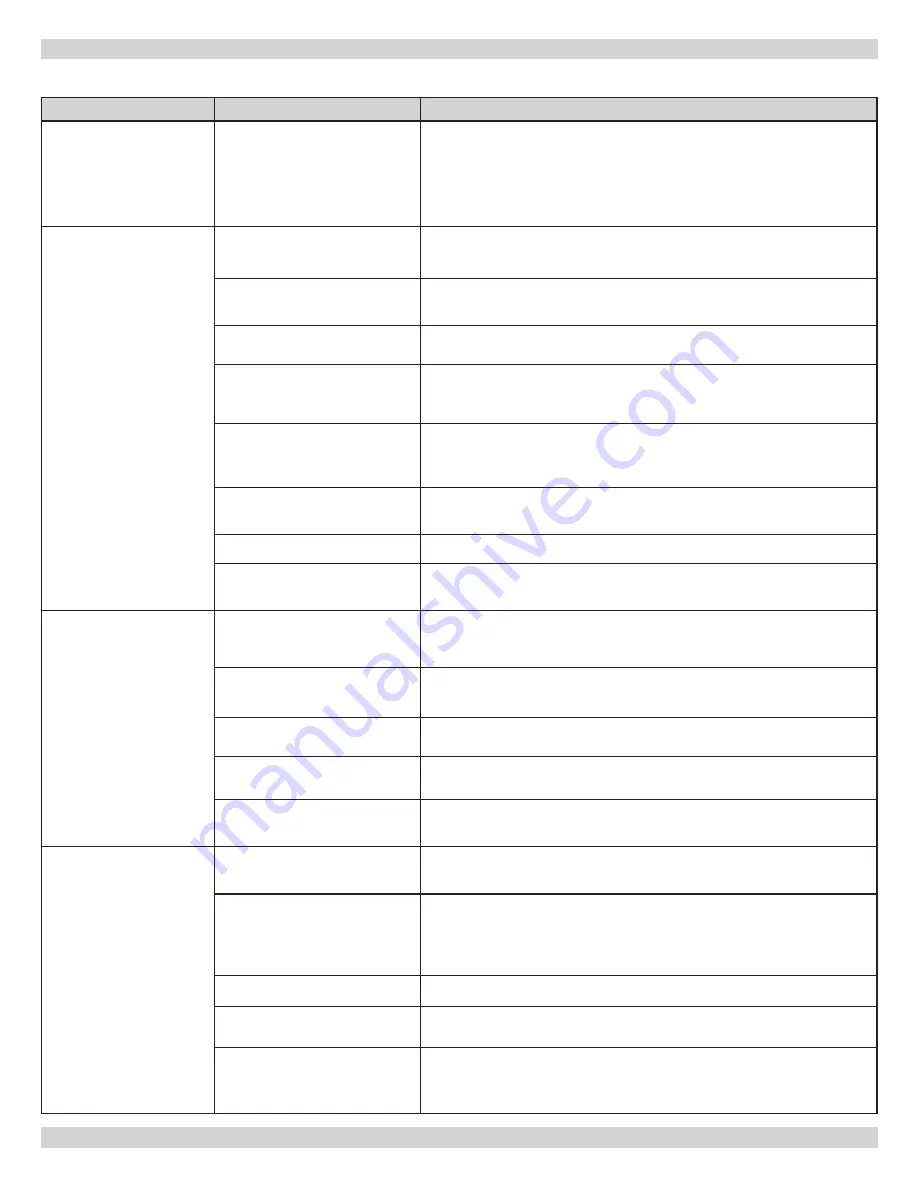
25
P/N 30149, Rev. G [12/15/2016]
Table C-2: System and General Troubleshooting
continued
Problem
Possible Cause
Remedy
Furnace starts, but cuts
out requiring manually re
-
setting oil protector reset
button.
Photo Cell (Cad Cell) defective.
If cad cell is dirty, clean it. Determine why cad cell is getting dirty. If cad
cell is poorly aimed, realign it.
NOTE: Photocell should have resistance of 100 KΩ in absence of light;
maximum of 1500 Ω in presence of light.
Verify room light is not leaking into the cad cell compartment. (See diag
-
nostic light section).
Furnace starts, but cuts
out requiring manually re
-
setting oil protector reset
button.
No fuel oil.
Check fuel oil supply.
Check that all hand operated fuel oil valves are in the open position.
Fill oil storage tank if necessary.
Clogged nozzle.
Replace nozzle with high quality replacement. Use rating plate or Tables in
Appendix A as a guide.
Clogged oil filter.
Replace oil tank filter or in-line filter if used.
Low oil pump pressure.
Connect pressure gauge to oil pump.
Adjust pump pressure, or replace oil pump if necessary.
Verify erratic pressure readings are not caused by defective fuel oil line.
Air getting into fuel oil lines, or
fuel oil line dirty, clogged, or in
some manner defective.
Check fuel oil lines. Replace any compression fittings found with high qual-
ity flared fittings.
Check for any signs of oil leaks. Any oil leak is a potential source of air or
contaminants.
Defective burner motor.
Check burner motor.
If burner motor is cutting out on over-load, determine why.
Replace if necessary.
Water or contaminants in oil.
Drain fuel oil storage tank; replace fuel oil. (Consult with fuel oil supplier).
Frozen oil line.
Gently warm oil line.
Insulate oil line. (Outdoor piping size may require increased diameter).
Oil burner sputtering at
nozzle
Electrodes out of adjustment or
defective.
Check electrode settings.
Check electrodes for dirt build-up or cracks in porcelain.
Poor igniter connections or
defective igniter.
Check contacts between the igniter and electrodes. If OK, replace the
igniter
Fuel oil filter clogged.
Replace fuel oil storage tank filter and / or fuel oil in-line filter.
Defective oil pump.
Check burner motor and / or fuel oil pump coupling.
Check oil pump pressure. Replace fuel oil pump if necessary.
Fuel oil line partially clogged or
contains air.
Bleed air from oil line.
If problem persists, replace oil line.
Excessive fuel oil
consumption.
System temperature rise too
high.
System temperature rise should not exceed 75°F. Check for clogged air fil-
ters. Check blower fan for excess dirt build-up or debris. Speed up blower
fan if necessary.
Poor “fan off” delay timing se
-
lection, (fan stops too soon).
Check “fan off” delay timing setting. Use duct thermometer in supply air
plenum take-off or first few inches of supply air trunk duct. Fan should
shut off at 90° - 100°F. Manipulate dip switch settings to come as close as
possible to this “fan off” temperature.
Fuel oil leak.
Check fuel oil line for leaks. Repair or replace if necessary.
Stack temperature too high.
Check stack temperature. Stack temperatures will normally range from
400° to 500°F. Check draft regulator. Draft should be set to -0.02 in. w.c.
Thermostat improperly adjusted
or in poor location.
Check thermostat heat anticipator setting against measured amperage
draw. Increase heat anticipator setting if necessary. If thermostat is being
influenced by drafts, sunlight, duct work, etc., relocate to suitable location.
APPENDIX C - SEQUENCE OF OPERATION AND TROUBLESHOOTING





































